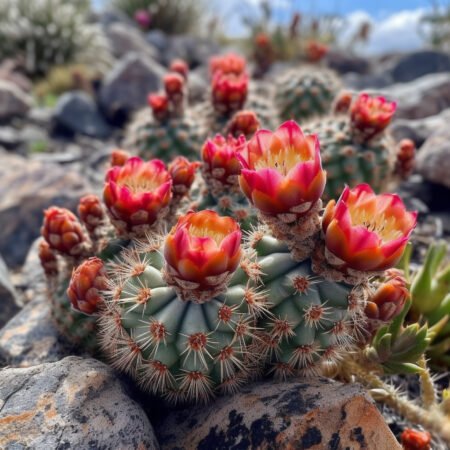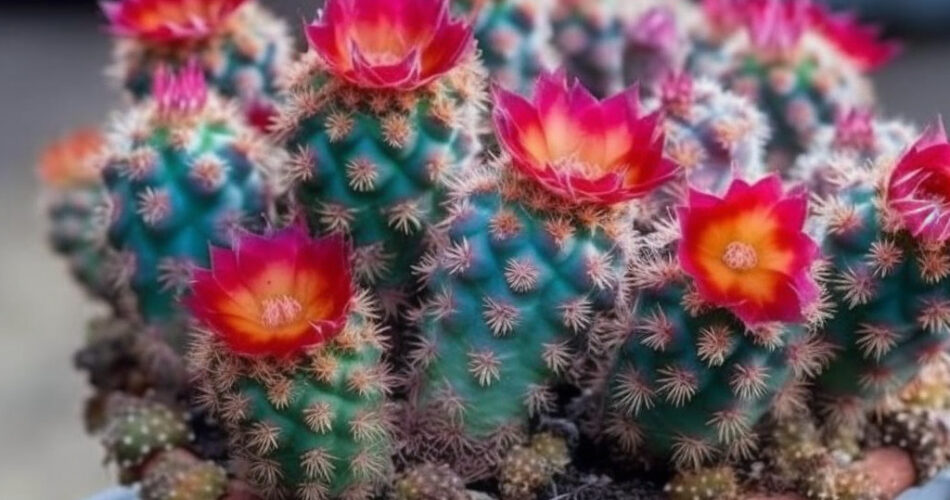Key Takeaways:
- The Austrocylindropuntia cactus is native to South America and thrives in arid regions with extreme temperatures.
- It has evolved unique adaptations such as a cylindrical stem for water storage, spines for protection and shade, and deep-reaching roots for water collection.
- The Austrocylindropuntia plays a critical role in its ecosystem as a food source, shelter, and soil stabilizer.
- Understanding its anatomy and growth cycle is essential for proper care and longevity of the cactus.
- The cactus consists of a central cylindrical stem, segmented with sharp spines, and a complex root system.
- Its growth patterns and lifespan are influenced by species, environmental conditions, and care practices.
1. The Fascinating Origins of the Austrocylindropuntia Cactus
The Austrocylindropuntia cactus, also known as the Eve’s Needle cactus, is a unique and fascinating plant that has captivated the attention of cactus enthusiasts and plant lovers alike. Native to the arid regions of South America, specifically Argentina, Paraguay, Bolivia, and Brazil, this cactus has a rich and diverse history.
1.1 A Journey through the Unique Habitat of the Austrocylindropuntia
This cactus thrives in the challenging conditions of its native habitat. It is often found growing in rocky, desert landscapes where water and resources are scarce. These cacti have adapted to survive in extreme temperatures, ranging from scorching hot days to freezing cold nights.
One of the most intriguing aspects of the Austrocylindropuntia’s habitat is its ability to grow in both high and low elevations. In the highlands, this cactus can be found clinging to the rocky slopes of mountains, while in the lowlands, it can be spotted growing in the plains and valleys.
These cacti often grow in clusters, forming dense, bushy formations. The spines on the Austrocylindropuntia act as protection against predators and provide shade to the plant, reducing water loss through evaporation.
1.2 The Evolutionary Adaptations of this Extraordinary Cactus
The Austrocylindropuntia cacti has undergone remarkable evolutionary adaptations to survive in its harsh environment. One of its most notable features is its cylindrical stem, which helps store water for prolonged periods of drought. This feature allows the cactus to endure extreme conditions and go without water for extended periods.
Additionally, the spines of the this cactus play a crucial role in its survival. They not only deter animals from feeding on the plant but also serve as a defense mechanism against excess sunlight. By shading the body of the cactus, the spines minimize sun exposure and reduce the risk of sunburn.
The root system of the Austrocylindropuntia is another remarkable adaptation. These cacti have a deep-reaching root system that helps them collect water from deep within the soil. This enables the plant to tap into hidden water sources and ensures its survival during prolonged dry spells.
1.3 Exploring the Ecological Importance
The Austrocylindropuntia cactus plays a vital role in its native ecosystem. As a primary producer, it provides a food source and shelter for various organisms. The flowers of the it are particularly attractive to pollinators such as bees and butterflies, aiding in the reproduction of other plant species.
The dense clusters formed by this cactus also serve as a habitat for small animals, offering protection from predators and extreme weather conditions. Many birds and rodents use these cacti as nesting sites, finding safety and refuge within the spiky branches.
Furthermore, the Austrocylindropuntia cactus plays a role in soil stabilization. The extensive root system of these cacti helps prevent soil erosion in arid regions, holding the soil together and preventing it from being washed away during heavy rains or strong winds.

2. Understanding the Anatomy and Growth Cycle of the Austrocylindropuntia
To care for the Austrocylindropuntia cactus effectively, it is crucial to understand its anatomy and growth cycle. This will provide insight into how best to provide for its needs and promote its health and longevity.
2.1 Decoding the Complex Structure
The Austrocylindropuntia cactus has a unique structure that sets it apart from other cactus species. It consists of a central cylindrical stem that can grow up to several feet in height. The stems are segmented and are covered in sharp spines, which can vary in color, depending on the species.
The spines not only provide protection but also aid in reducing water loss by creating a barrier between the plant and the surrounding air. Some varieties of the Austrocylindropuntia feature small, hair-like structures known as glochids, which are barbed spines that easily detach and stick to whatever comes into contact with them.
Beneath the surface, the Austrocylindropuntia cactus has a complex network of roots that extend deep into the ground. These roots absorb water and nutrients from the soil, supporting the overall health and growth of the plant.
2.2 Shedding Light on the Growth Patterns and Lifespan of this Cactus
The growth patterns and lifespan of the Austrocylindropuntia cactus can vary depending on various factors such as species, environmental conditions, and care practices. On average, these cacti have a slow growth rate.
FAQ
Question: What is the Austrocylindropuntia cactus?
Answer: The Austrocylindropuntia cactus, also known as the Eve’s Needle cactus, is a unique plant native to South America that thrives in arid regions with extreme temperatures.
Question: What are some unique adaptations of the Austrocylindropuntia cactus?
Answer: The Austrocylindropuntia cactus has evolved unique adaptations such as a cylindrical stem for water storage, spines for protection and shade, and deep-reaching roots for water collection.
Question: What role does the Austrocylindropuntia cactus play in its ecosystem?
Answer: This cactus plays a critical role in its ecosystem as a food source, shelter, and soil stabilizer.
Question: How can I care for the this cactus?
Answer: To care for the cactus effectively, it is important to understand its anatomy and growth cycle and provide for its specific needs.
Question: What is the anatomy of the Austrocylindropuntia cactus?
Answer: The Austrocylindropuntia cactus consists of a central cylindrical stem segmented with sharp spines and a complex root system.
Question: How does the it grow and what is its lifespan?
Answer: The growth patterns and lifespan of the Austrocylindropuntia cactus can vary depending on species, environmental conditions, and care practices.
Question: Can I grow the this cactus outside of its native habitat?
Answer: It is possible to grow the Austrocylindropuntia cactus outside of its native habitat with proper care and consideration of its specific needs.
Question: What are some interesting facts about the Austrocylindropuntia cactus?
Answer: The Austrocylindropuntia cactus has fascinating origins, evolutionary adaptations, and ecological importance, making it a unique and captivating plant.




Comments